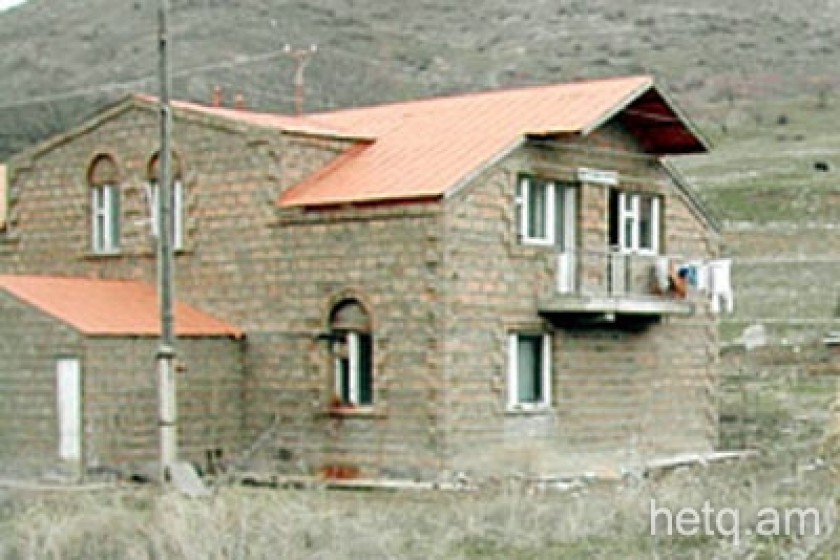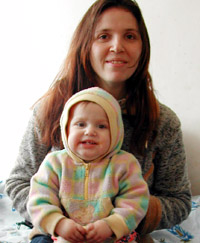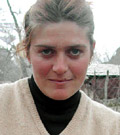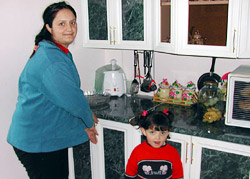
Philanthropy Missing Its Mark
A number of NGOs and psychologists who deal with issues related to graduates from children's homes stress that many initiatives aimed at helping children raised in such homes often fail to produce the desired results only because after receiving a certain amount of material assistance, these children are not prepared to live and build their future on their own. Over the last few years, the NGO Armenian Democratic Forum has studied the behavior of some 300 graduates of children's homes. “Very often they have difficulties adapting to living alone and independently. Of course, not always, but often they seem to be just waiting for something to happen, rather than undertaking or creating something on their own. It's not their fault, but it shouldn't go on like this forever,” Anahit Sahakyan, a psychologist and team leader for the organization said.
In the 1990s American-Armenian philanthropists Mike and Sona Ohanians funded the construction of four two-story stone houses in thevillageofHermonof the Vayots Dzor Marz, which accommodated seven families of orphans and children of freedom fighters who died in action were accommodated in these houses. The construction of each house cost $12,000. Each house is designed for two families, with a separate entrance, farmyard, and cattle-shed for each family. ThevillageofHermonwas selected because it was small, with only fifty families residing there, and the village needed additional residents. There are three to five pupils in each class in the village school, thirty students overall. Hermon is located 25 kilometers from the provincial center Yeghegnadzor, and there is one bus a day that runs back and forth to the city.
Today only three out of the seven families are still living in Hermon. The other houses are vacant and the philanthropists decided to stop the construction of the remaining six houses as was planned. All the graduates that lived in Hermon had grown up at the Gavar Children's Home.
“These seven families settled here in 2000. Each family had 1,200 square-meters of land; we planted fruit trees and gave each of them hens, sheep, a cow, a horse, and five beehives. We provided them with furniture as well – tables, chairs, gas stoves, refrigerators, washing machines, bed-clothes… this opportunity for all of them was something like a lottery ticket. But they were not prepared for living here. In order to live in village, one has to deal with agriculture and cattle breeding but they sold what they were provided with and left. What else could have we done for them? They had selling all this in their minds. They didn't want to throw in their lot with these houses and this village,” said the Mayis Mkrtchyan, chairman of Syunik, the NGO that had signed the contracts with these seven families on behalf of the philanthropists.
 According to the contract that Suzanna Mashkovicha's family signed in 2001, after a five-year-term expired the ownership rights to the house and the land would pass to her free of charge. But now this clause is not valid.
According to the contract that Suzanna Mashkovicha's family signed in 2001, after a five-year-term expired the ownership rights to the house and the land would pass to her free of charge. But now this clause is not valid.
“Now the philanthropists refuse to give them the title to land, since they are concerned that they will sell the houses or rent them out. But those houses were not built for selling or renting them out, were they? They can live in these houses without time-limits, but cannot treat them as their property,” Mayis Mkrtchyan said.
Suzanna Mashkovicha lived in thevillageofHermonwith her husband and three children until 2005. After that she was given an apartment inYerevanthrough the program “State Assistance to the Graduates of Children's Care Organizations. Now she lives in a 32-square-meter-room in a former dormitory in Erebuni. “We decided to come toYerevanbecause our next-door neighbors were constantly creating problems. There were fights, thefts, we couldn't live in harmony. But we had received a lot of help in Hermon and some people didn't appreciate it, and because of a couple of people we all lost out,” Suzanna said.
 29-year-old Armine Gevorgyan has lived in Hermon with her husband and five children for five years now. Armine grew up in the Gavar Children's Home form the time that she was three, and later moved to Meghri. Neither Armine nor her husband have jobs; they live on the 39,000 dram allowance she receives as a single mother since their marriage is not registered.
29-year-old Armine Gevorgyan has lived in Hermon with her husband and five children for five years now. Armine grew up in the Gavar Children's Home form the time that she was three, and later moved to Meghri. Neither Armine nor her husband have jobs; they live on the 39,000 dram allowance she receives as a single mother since their marriage is not registered.
Armine said that she was unable to work and her husband did not want to. “When we were given the house, we got some furniture and livestock - hens, sheep, and a cow. Now we don't have livestock – some animals died, we sold some others and slaughtered the remaining ones. We couldn't raise cattle, we were not used to such things,” Armine said.
 Armine likes her house a lot: “Who else has such a house in the village?” One of her kids is now in the hospital, he fell from the second floor. “I don't know how old I am, my Mom doesn't teach me. She can't say it either, she is little,” Armine's older daughter said on her and her sister's behalf.
Armine likes her house a lot: “Who else has such a house in the village?” One of her kids is now in the hospital, he fell from the second floor. “I don't know how old I am, my Mom doesn't teach me. She can't say it either, she is little,” Armine's older daughter said on her and her sister's behalf.
“Unfortunately, so far I haven't seen a fully happy family among the graduates from children's homes, even when both spouses are from children's homes. I have even noticed that the same problems are passed on to their children. It's called social heritage, when the child builds his or her own family on the basis of the family model he or she had seen,” Anahit Sahakyan said.
 21-year-old Hayarpi Voskanyan's father was killed in action in thevillage ofAreni in 1990 and as a daughter of a freedom fighter she has lived with her husband and the daughter in Hermon since 2003. Hayarpi's husband works at the Hermon hydroelectric plant two kilometers from the village, earning 25,000 drams a month. Like the others, Hayarpi's family received the livestock and beehives in assistance. She says that neither she nor her husband could have bought such a house themselves.
21-year-old Hayarpi Voskanyan's father was killed in action in thevillage ofAreni in 1990 and as a daughter of a freedom fighter she has lived with her husband and the daughter in Hermon since 2003. Hayarpi's husband works at the Hermon hydroelectric plant two kilometers from the village, earning 25,000 drams a month. Like the others, Hayarpi's family received the livestock and beehives in assistance. She says that neither she nor her husband could have bought such a house themselves.
“We have gotten used to village life, and every year we produce about 500 kilograms of honey. We like living here a lot, but we don't know whether this house will be our own or not. We want to plant an orchard here, but I want to be sure that what I created will pass on to my children,” Hayarpi said.
“Now we are thinking that students or teachers who would like to live in this village and teach at the school could live in these houses. We have to get the philanthropists' approval for that. Last summer they came toArmeniabut they didn't want to visit Hermon. We want these houses to be left to the families that are prepared to live in the village; the other houses will serve other charitable purposes,” Mayis Mkrtchyan said.
 Videos
Videos Photos
Photos




Write a comment